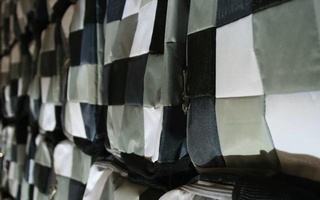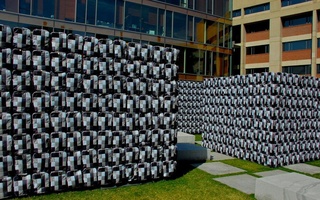Clinging to one of its last potential claims to relevance, Time Magazine published yesterday its annual list of the “100 most influential people in the world,” spanning from Wael Ghonim to Patti Smith. Twenty-fourth on the list was Chinese artist Ai Weiwei, responsible for the Birdnest at the 2008 Beijing Olympics, as well as a number of other elaborate conceptual projects. Ai’s inclusion had as much to do with his well publicized detention by Chinese authorities as with any item on his artistic resumé. Accompanying a three-part photograph of him shattering a jug was a curiously aggressive blurb from U.S. ambassador Jon Huntsman: “It is very sad that the Chinese government has seen a need to silence one of its most innovative and illustrious citizens. For the world, Ai continues to represent the promise of China.”
This type of appreciation for Ai’s art seems a distinctly mixed blessing. Much of the strength of Ai’s more recent work derives from its efforts to efface the presence of the artist, to convey the overwhelming feeling of being caught up in something greater than oneself. Because of the political attention, however, Ai’s own artistic personality has now replaced his work, overshadowing the ambitions of his delicate subject matter.
It’s worth visiting some of Ai’s work on display at Harvard now, outside the Northwest Labs building. Hundreds of quilted backpacks are affixed to giant columns, a memorial to the children killed in the 2008 Sichuan earthquake. Ai believes that the “tofu construction” of the government schools was responsible for many of the children’s deaths, a fact officials have been trying to cover up. This week the packs looked particularly stark, serried against a white sky and unmoving despite fierce wind; the drab coloring of their fabric helped them blend into the drabness of a Cambridge spring. The work has no name, listed simply as “Untitled”: perhaps because the tragedy’s magnitude seems so great any title would be an injustice. The effect might have been greater than intended; with no markers whatsoever, most students walking down Oxford Street do not give the exhibit a second glance. If one does look closely, however, the sheer build-up of objects is tremendously moving.
The project marks a departure from many of Ai’s previous efforts. After film school in Beijing, Ai studied at Parsons in the ’80s. Like many other New York artists, he dabbled in Dada and ready-mades, which acquire meaning transcending their status as mere objects only through the explicit presence of their creator. Ai has a recognizable face—soft cheeks, playful eyebrows, a distinctive beard—and he was fond of featuring his own image in his work.
It was when he moved back to China to be with his ailing father that Ai grew interested in the social landscape of his country, and began to ask how one could utilize modern design techniques to highlight political issues. Repetition provided the key. In “Untitled,” he plays with the idea of losing one’s individuality in the mass; his stated ideal is a “stylelessness” free of narration, whether his own or that of the state. The closest analogue is another work of his called “Sunflower Seeds,” in which the enormous foyer of London’s Tate Modern became the scattering ground for thousands of seeds people could walk on, pick up, and sift through their hands. Ai’s oeuvre can be alternatingly brilliant and gimmicky, but this angle seems a particularly powerful one. To move away from the self-conscious artistic presence toward a more universal understanding of the past suggests a vast ambition to come to terms with the tragedies of history—not only as a single, subjective individual but also in a grander capacity.
Indeed, Ai’s backpacks are part of a larger exhibit organized by the Graduate School of Design called “Divine Comedy.” Against the relentlessly modern backdrop of the GSD lobby, Danish-Icelandic artist Olafur Eliasson takes up the present with a series of 54 “sensation-producing body machines.” To him, art is not about creating, but about “organizing and transforming”; his theme is the bafflement of a modern world to which every person brings a unique perspective, evoking the complex, paranoid novel of systems.
It is Ai’s contribution though, grappling with history, that conveys the clearest and most powerful message. Turning to the past makes sense—over and over, we realize how much it matters, digging it up again to reexamine its particulars. Without care, events fade; a collective presence is needed to anchor them, not just an individual one.
This is Ai’s project, and it fits into the trajectory of the larger architectural landscape away from the solitary artist. The design world looks askance at self-promoters far more than does the world of cinema (in which the auteur still has a hold) or literature (by definition a solipsistic enterprise). Today’s large-scale projects often require computer scientists, builders, and entire studios; a work can move from start to finish without the designer himself. In the current issue of Harvard Design Magazine, architects comment on the disappearance of the visionary architect altogether. The self-conscious role Ai is now being expected to assume—the role of the persecuted artist—thus seems singularly misguided. In this respect, ironically, the western media is mirroring the Chinese government: Drawing attention to Ai’s personality, it distracts from his art, and from all the serious concerns behind it.
Jessica A. Sequeira ‘11, a former associate editorial editor, is a Social Studies concentrator in Winthrop House. Her column appears on alternate Fridays.
Read more in Opinion
Her Step BackwardRecommended Articles
-
 Chinese Artist Responsible for NW Labs Installation Detained
Chinese Artist Responsible for NW Labs Installation Detained -
 Ai Weiwei’s 5,335 Backpacks Hold Political, Artistic Charge
Ai Weiwei’s 5,335 Backpacks Hold Political, Artistic Charge -
From Terrorism to the Spectacle of TerrorPerhaps nothing provokes such instantaneous spectacle as surely as terrorism
-
Taking on the AINot everything about the Academic Index is as clear-cut as how it is calculated.
-
 Admissions Expert Anna Ivey Gives Advice on Early Action and Early Decision
Admissions Expert Anna Ivey Gives Advice on Early Action and Early Decision -
An Introduction to the Academic IndexWith varsity recruiting season in full swing, high school athletes across the country are committing to play for their dream schools. But for athletes being recruited to the Ivy League the process is slightly different.













